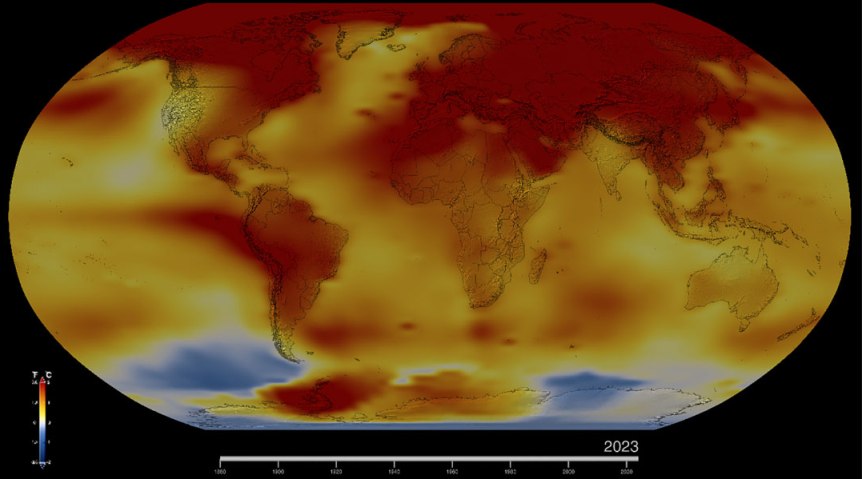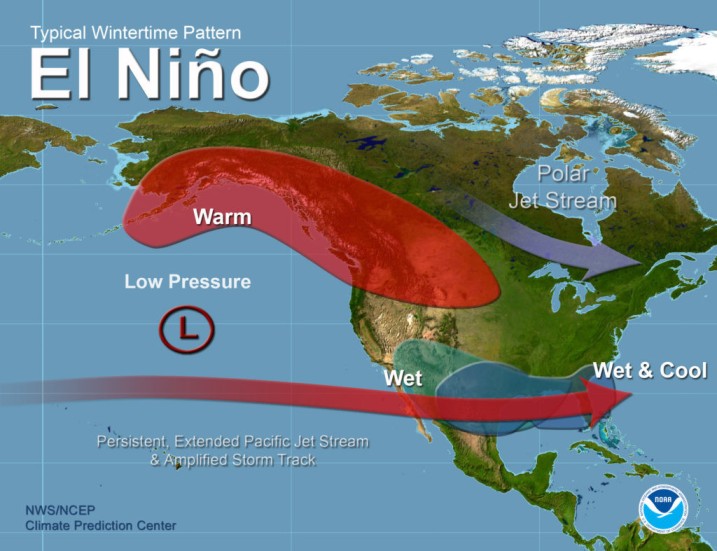According to NASA analysis, the average surface temperature of the Earth in 2023 was the highest on record. Global temperatures last year were about 2.1 degrees Fahrenheit (1.2 degrees Celsius) above the average for NASA’s baseline period (1951-1980), scientists at NASA’s Goddard Institute for Space Studies (GISS) in New York reported.
In 2023, hundreds of millions of people around the world experienced extreme heat, with each month from June to December setting a world record for the corresponding month. July was the hottest month on record. Overall, the Earth was about 2.5 degrees Fahrenheit (or about 1.4 degrees Celsius) warmer in 2023 than the average at the end of the 19th century, when modern record-keeping began.

This map of Earth in 2023 shows global surface temperature anomalies, or how much warmer or colder each region of the planet was compared to the average from 1951 to 1980. Normal temperatures are shown in white, and above normal temperatures are shown in red and orange, and temperatures below normal are highlighted in blue. An animated version of this map shows global temperature anomalies changing over time since 1880
“The extraordinary warming we are experiencing is nothing like we have seen before in human history,” said Gavin Schmidt, director of GISS. “This is caused primarily by fossil fuel emissions, and we are seeing the consequences in the form of heat waves, heavy rainfall and coastal flooding.” Although scientists have strong evidence that the planet’s long-term warming trend is caused by human activity, they are still studying other phenomena that could influence annual or multi-year climate changes, such as El Niño, aerosols and pollution, and eruptions volcanoes.
Typically, the largest source of interannual variability is the oceanic climate of the El Niño–Southern Oscillation in the Pacific Ocean. The pattern has two phases – El Niño and La Niña – when sea surface temperatures along the equator switch between warmer, average and cooler temperatures. During 2020–2022, three consecutive La Niña events occurred in the Pacific Ocean, which tended to lower global temperatures. In May 2023, the ocean transitioned from La Niña to El Niño, often coinciding with the hottest years on record.

However, record temperatures in the second half of 2023 occurred before El Niño peaked. Scientists expect to see the biggest effects of El Niño in February, March and April.
Scientists also examined the possible effects of the Hunga Tonga-Hunga Haapai submarine volcano erupting in January 2022, which released water vapor and small particles or aerosols into the stratosphere. A recent study found that volcanic aerosols, by reflecting sunlight off the Earth’s surface, led to an overall slight cooling of less than 0.2 degrees Fahrenheit (or about 0.1 degrees Celsius) in the Southern Hemisphere after the eruption.
“Even with periodic cooling factors like volcanic eruptions or aerosols, we will continue to break records as long as greenhouse gas emissions continue to rise,” Schmidt said. “And unfortunately, last year we again set a new record for greenhouse gas emissions.”
NASA uses surface air temperature data collected from tens of thousands of weather stations, as well as sea surface temperature data collected from instruments on ships and buoys. These data are analyzed using methods that take into account the varying distances between temperature stations around the world and the effects of urban heating, which can skew the calculations.

Independent analyzes by NOAA and the Hadley Center (part of the United Kingdom Met Office) concluded that global surface temperatures in 2023 are the warmest since modern record-keeping began. These scientists use much of the same temperature data in their analyses, but use different methodologies. While the rankings may vary slightly between reports, they are generally consistent and show the same ongoing long-term warming in recent decades.
Building on a half-century of research, observations and models, the Biden-Harris Administration, including NASA and several federal partners, recently launched the U.S. Greenhouse Gas Center to make critical climate data available to decision makers and citizens. The Center supports collaboration among U.S. government agencies and the nonprofit and private sectors to make air, ground, and space-based data and resources available online.
NASA’s complete set of global surface temperature data through 2023, along with details of how NASA scientists conducted the analysis, is publicly available on GISS. GISS is a NASA laboratory managed by the Earth Sciences Division at the agency’s Goddard Space Flight Center in Greenbelt, Maryland. The laboratory is affiliated with the Earth Institute and the School of Engineering and Applied Sciences at Columbia University in New York.




